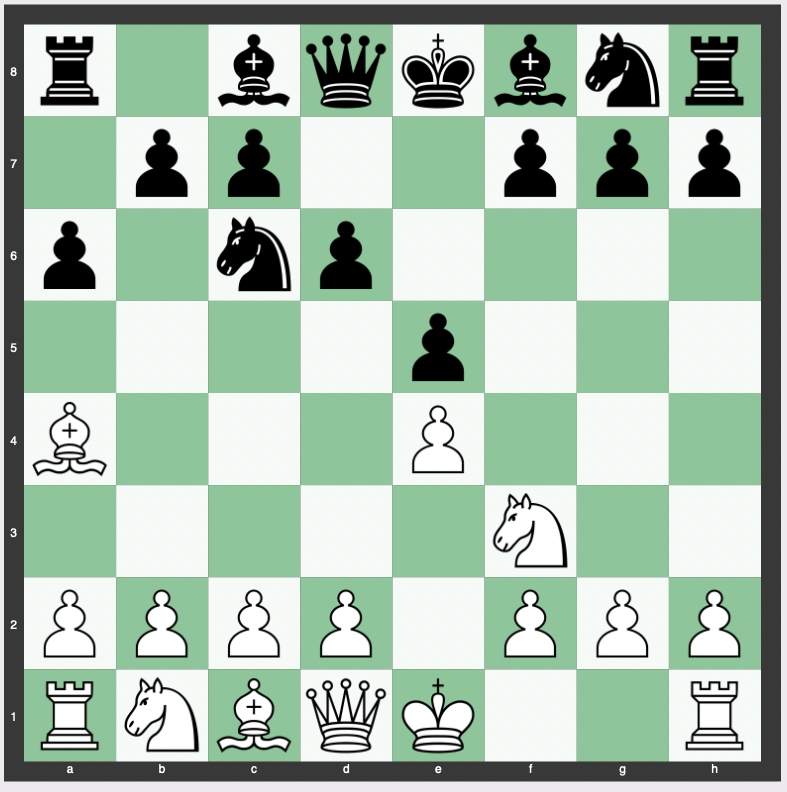Within the Ruy Lopez, one variation that has witnessed both historical significance and modern refinement is the Modern Steinitz Defense.
Below we look into the Modern Steinitz Defense, analyzing its move order, theory, and strategy.
We will also explore its variations, history, suitability for beginners or intermediates, and its usage at the Grandmaster level.
Move Order of the Modern Steinitz Defense
The Modern Steinitz Defense is characterized by a specific move order in the Ruy Lopez opening.
This opening begins with 1. e4 e5 2. Nf3 Nc6 3. Bb5 a6 4. Ba4 d6.

The crucial move that defines this defense is 4…d6, where black aims to solidify the center and prepare to develop the bishop to e7.
Theory, Strategy and Purpose of the Modern Steinitz Defense
The main objective of the Modern Steinitz Defense is to achieve a solid and somewhat passive setup, aiming for long-term advantages instead of early tactical skirmishes.
Black’s fourth move, d6, strengthens the center and allows for the development of the dark-square bishop.
This can lead to a solid but somewhat passive position for black, focusing more on solidifying the pawn structure and less on early piece activity.
Variations of the Modern Steinitz Defense
There are several main variations within the Modern Steinitz Defense.
The Delayed Exchange Variation (5. Bxc6+ bxc6 6. d4), where white immediately challenges the center, is one of them.
Another popular variation is 5. c3 followed later by d4, where white aims to challenge black’s central pawns and open lines for their pieces.
Black’s responses can vary widely, offering numerous sub-variations and strategic considerations.
Sample lines include:
5. O-O Nf6 6. c3 Be7 7. d4 O-O 8. Bc2 Bg4 9. d5 Nb8 10. h3 Bh5 11. Nbd2 c6
5. c3 Nf6 6. d4 Be7 7. O-O O-O 8. Re1 b5 9. Bc2 exd4 10. cxd4 Nb4 11. Bb3 c5 12. a3 Nc6 13. h3 Nxd4 14. Nxd4 cxd4 15. Qxd4 Be6
5. c3 Nf6 6. d4 Bd7 7. Bc2 g6 8. O-O Bg7 9. h3 O-O 10. Re1 Re8 11. d5 Ne7 12. c4 b5 13. a4 c6 14. axb5 axb5 15. Rxa8 Qxa8 16. dxc6
5. c3 Nf6 6. d4 Be7 7. O-O O-O 8. Re1 b5 9. Bc2 exd4 10. cxd4 Nb4 11. d5 c5 12. dxc6 Bg4 13. Bb3 Nxc6 14. h3 Bxf3 15. Qxf3 Nd4 16. Qd3 Nxb3 17. Qxb3 Re8 18. Nc3 Nd7 19. Be3
The Modern Steinitz Defense is evaluated at about +0.60 for white.
History of the Modern Steinitz Defense
The Modern Steinitz Defense traces its origins back to Wilhelm Steinitz, the first official World Chess Champion.
He regularly employed this defense during his matches in the late 19th century.
Over the years, this defense has been adapted and modified, leading to its current form, commonly known as the Modern Steinitz Defense.
It remains a part of chess theory, a testament to its historical importance and resilience.
Whether It’s Good for Beginners or Intermediates
While the Modern Steinitz Defense is relatively straightforward, its strategy of long-term solidity and positional play might be more suitable for intermediate players who have a better understanding of these complex aspects of chess.
Beginners might find this defense challenging due to its inherent passive nature and the depth of understanding required to leverage the long-term advantages.
However, learning it can be a beneficial exercise in understanding pawn structures and defensive play.
How Often It’s Played at the Grandmaster Level
At the Grandmaster level, the Modern Steinitz Defense is not as frequently seen as other more aggressive defenses against the Ruy Lopez.
The reason for its infrequent usage lies in its passive nature, as grandmasters usually prefer more dynamic defenses that offer counterattacking chances early in the game.
However, it still surfaces occasionally in Grandmaster games, especially as a surprise weapon or when a solid, less tactical game is preferred.
The Ruy Lopez | Modern Steinitz Defense
Conclusion
The Modern Steinitz Defense is a significant part of the broad and intriguing world of chess openings.
While not as frequently used at the top level as other defenses, it provides a unique blend of solid pawn structures and positional play.
This defense, with its rich history and modern relevance, offers valuable insights into the strategic depth of chess, showcasing the game’s beauty in every move.
Whether you’re an intermediate player aiming to deepen your understanding of chess or a beginner seeking to broaden your opening repertoire, delving into the Modern Steinitz Defense promises a unique and enriching journey.


